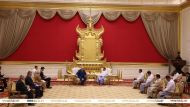
Image credit: RIA Novosti
MINSK, 21 December (BelTA) – How the so-called tulip revolution began and how it ended has been covered by the latest episode of the documentary series Time Chose Us aired by the TV channel Belarus One, BelTA has learned.
In 2005 Kyrgyzstan experienced a color revolution, which was called the “tulip revolution”. The formal reason for the mass riots was dissatisfaction with results of the parliamentary elections. The actions, which started ostensibly peacefully, gradually turned into real street-to-street fighting.

Andrei Manoilo, a political scientist and professor at Moscow State University named after M.V. Lomonosov, noted that the color revolution in Kyrgyzstan followed a classic scenario. “It used classic technologies of organizing a coup d'état in conditions of artificially created instability. Various slogans were thrown in, which agitated the masses. Then conditions were created for people to merge into a mob, which became aggressive,” Andrei Manoilo said.

American political strategists decided to exploit contradictions of Kyrgyzstan’s elites. The country’s proximity to Russia was a significant reason for the coup d'état. Before the revolution, an American foundation for the support of mass media even published Gene Sharp’s work “From dictatorship to democracy.” It was the notorious playbook for staging “non-violent” protests.
While the protesters were busy destroying Bishkek, the mass media environment was filling up with rumors that Belarus would be next.

“We kept silent officially back then, let's put it that way. But you have to realize that Kyrgyzstan is a kindred country for us. It is an active participant in both the Commonwealth of Independent States and the Collective Security Treaty Organization. We have always had good relations. Essentially my visit to Kyrgyzstan to establish contacts with the new leadership of the country was the reaction. I met with the prime minister, with my counterpart, with President Bakiyev. And we had a rather deep and friendly conversation, during which we agreed to continue all the projects we had in the works,” recalled Belarus’ Minister of Foreign Affairs (2003-2012) Sergei Martynov.
The protests culminated on 24 March. Of course, these protests were called peaceful only in Sharp’s playbook. In reality, they claimed thousands and thousands of lives in many countries. Despite the success of the “tulip revolution” the Americans miscalculated the situation. Kurmanbek Bakiyev, who rose to power, stayed on friendly terms with Belarus and Russia without bowing to the West.
Unfortunately, Bakiyev’s former supporters betrayed him in 2010. He was forced to leave the country, and Kyrgyzstan finally entered the cycle “a revolution every five years”.
You can learn even more about significant and vivid events of the past years in BelTA’s YouTube-project “How it was: DOC”.













